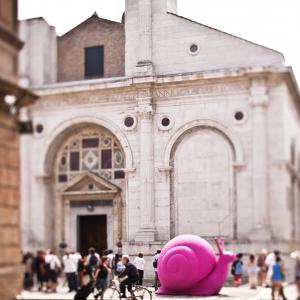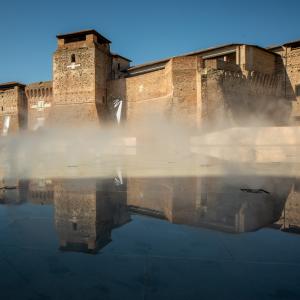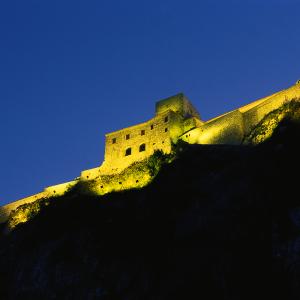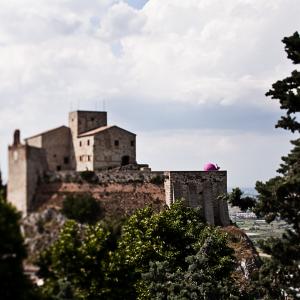The Seigneury of the Malatesta and Montefeltro families
The lands of the province of Rimini have a trait that has bonded and united them for hundreds and hundreds of years, that is the fact that these lands are the heart of an ancient historical region: the Seigneury of the Malatesta and Montefeltro families.
Between the Middle Ages and the Renaissance, the Malatesta family was among the most important in Italy, one of the great families who, together with the Medici family, the D'Estes, the Gonzagas, the Borgias, and a few others, really marked Italian and European history and culture.
TWO SEIGNEURIES COMPETING AGAINST EACH OTHER
The history of the Rimini hills starts from the very important Villanova settlements of Verucchio and then is permeated by the great Roman civilization. But it was the Middle Ages and the Renaissance that marked the entire territory leaving indelible traces, which today can be admired in the urban planning, architecture, and monuments of all the towns along the plains and the hills of the province of Rimini.
And during the years of the 12th-15th centuries, the protagonists were two Seigneuries, the Malatestas and the Montefeltros, whose vicissitudes unite the territory which owes its incomparable richness and beauty also to them.
Both originally from Montefeltro, the two families set out in search of territories on which to exercise seigneurial powers. It was inevitable that the expansion of the respective domains, located to the north and to the south of the valleys, would lead to friction.
The Montefeltros had received the county of Urbino in the thirteenth century, after having already dominated the territory of Montefeltro for about a century.
The Malatestas (formerly Malatesti) in the same period possessed the territories of Pennabilli and had expanded to Verucchio and on towards the middle Marecchia valley. The rivalries sharpened and then exploded in the first half of the 15th century, under the resourceful and determined guides of Sigismondo Pandolfo Malatesta, Seigneur of Rimini and Fano, and Federico da Montefeltro, Duke of Urbino, both apostolic vicars. A continuous conflict began between the two, resulting in battles, deceptions, and endless clashes. Federico prevailed as he was able to gain the trust of the Pope, while Sigismondo was excommunicated and lost everything, except his much-loved Rimini.
Read more
The Montefeltros
The first Montefeltro of the family was Count Antonio da Montefeltro, a descendant of the Carpegna dynasty, the legendary figure who acquired the name as the bearer of an illustrious lineage.
Montefeltro designated the area of San Leo, Mons Feretrus, in honor of the temple dedicated to Jupiter Feretrio located there. Later, Montefeltrano’s son consolidated the name and prestige of the family, making it among the most powerful in the region. Even when they became counts of Urbino they lived in San Leo; Guido I da Montefeltro, also called Il Vecchio (The Old One), was born in San Leo in 1255.
Dante Alighieri, in the Divine Comedy, places him in Hell, in the Eighth Bolgia (Pit). Pope Eugene IV in 1443 appointed Oddantonio II da Montefeltro and Federico’s father, the first duke of Urbino, a town that became the capital of the State and was ready to become one of the focal points of the Italian Renaissance. This was the work of Federico himself who called up the greatest writers and artists of the time, from Piero della Francesca to Luciano Laurana, to Francesco di Giorgio Martini who built the splendid ducal Palace. The decline of the town began with the transfer of the capital to Pesaro in 1523.
The Malatestas
The origins of the Malatestas are also in Valmarecchia; The first documents that mention them, dating back to the 12th century, concern land estates in southern Romagna and bear traces of conflict with the Municipality of Rimini. There were so many estates that they managed to control the roads of the Rimini hinterland, concentrating on the estates of Pennabilli and Verucchio, which boast of having given origin to them.
What was decisive was the ancient kinship with the most illustrious and powerful feudal family in the area: the Carpegna family. By controlling the territory and communication routes, agricultural production, and trade, they began to exert pressure on Rimini. They came to war, which ended in 1197, with an act of reparation.
The municipality of Rimini was linked to the interests of the Malatesta family; it made them citizens, granted them a seat on the city council (1206), and invited them to live permanently within the city walls. From 1239 to 1247 Malatesta dalla Penna (Malatesta I), who in 1223 had been podestà of Pistoia, became podestà of Rimini. He was well known as Malatesta da Verucchio, "the centenary", born in Verucchio in 1212 and died in Rimini in 1312, called Mastin Vecchio (The old Mastif) due to his old age, as reported by Dante in his Divine Comedy (Inferno XXVII verses 6-48).
He was the father of other Dantesque figures, those of Paolo and Gianciotto, the deformed and murderous husband of Francesca and his brother. The way was opened for the exercise of absolute power over the town. Within a few decades, the family took possession of all the civil and religious offices by divesting the citizen bodies. They counted on enormous wealth and necessary support obtained from wars, astute marriage policies, and alliances, but they lacked the noble title. Therefore, they tried to credit themselves with very ancient origins: Noah, Tarcone, the Trojan hero cousin of Hector and Aeneas; or even Otto III, emperor of the Holy Roman Empire; or Scipio the African, of whom Sigismondo Pandolfo, the most famous of the Malatestas, Seigneur of Rimini from 1432 to 1468, was a very keen follower.
Sigismondo and his Rimini
At the age of 15, in 1432, Sigismondo Pandolfo Malatesta became the Seigneur of Rimini and Fano. For years, he was engaged in military campaigns throughout Italy, gaining fame and accumulating wealth, which he used to make his capital and his court worthy of the great Seigneuries of the time. It is thanks to him that Rimini had the honor of being home to the first Renaissance building, the Tempio Malatestiano, designed by Leon Battista Alberti, and enriched with frescoes by Piero della Francesca. It was the mausoleum of Sigismondo and his wife, Isotta degli Atti, but also of Giorgio Gemisto Pletone, one of the court philosophers who surrounded the seigneur. His aggressive character played a great role both in his glorification and in his downfall.
The intricate Italian political situation did the rest marking his decline at just over forty years old. Failure to fulfill the obligations assumed, infidelity to the Pope whose policy he no longer shared, and the military occupation of territories under the jurisdiction of the Montefeltros, faithful supporters of the Church's policy, led him to lose everything except the city, symbol of his power, while Federico not only recovered what had been his, but he expanded his possessions to include the Malatesta castles. He died at the age of just 51, a man who, at the age of 13, had already led an army, dealing, in recent years, with the continuation of the work on his Temple. Rimini like Urbino was a capital of the Renaissance; great artists, men of letters, and humanists passed through it.
With his death, the town fell into the background, while other capitals remained protagonists in the centuries to come.



